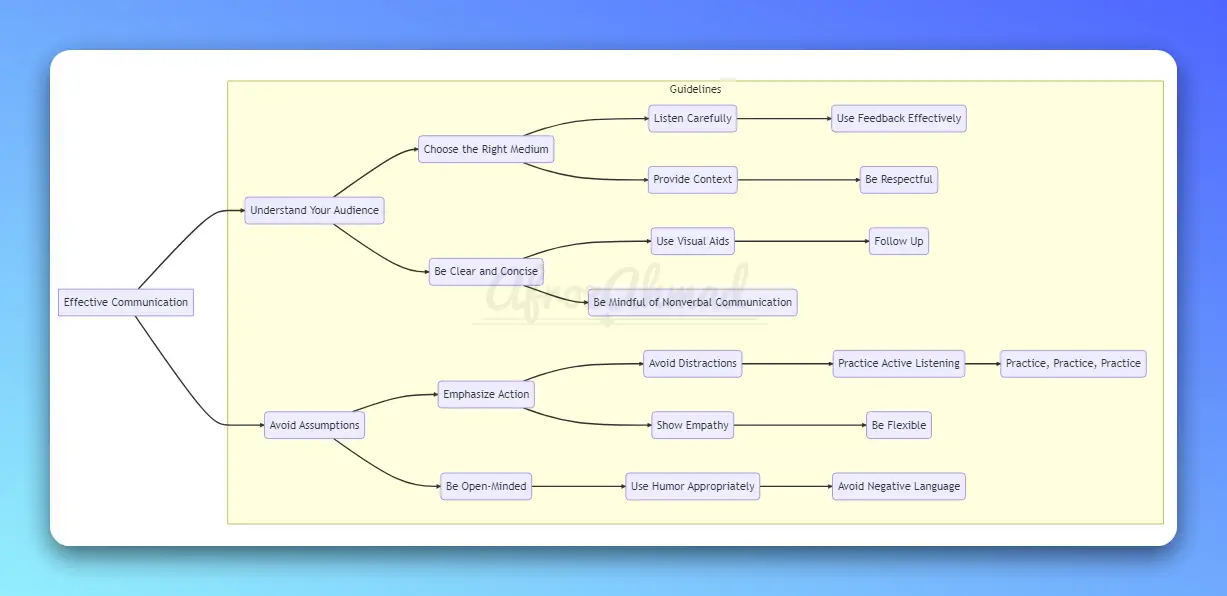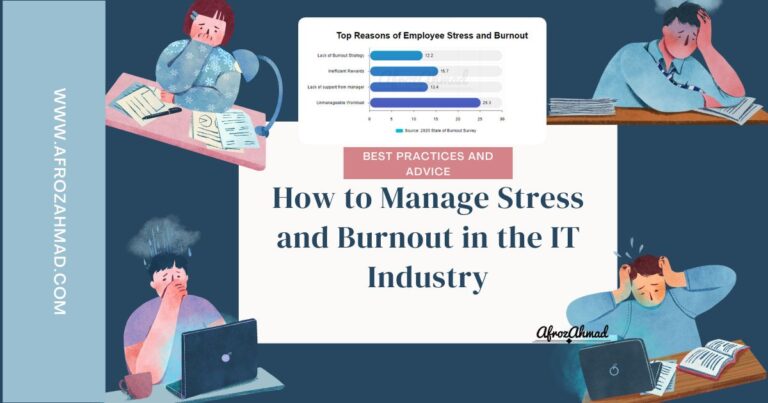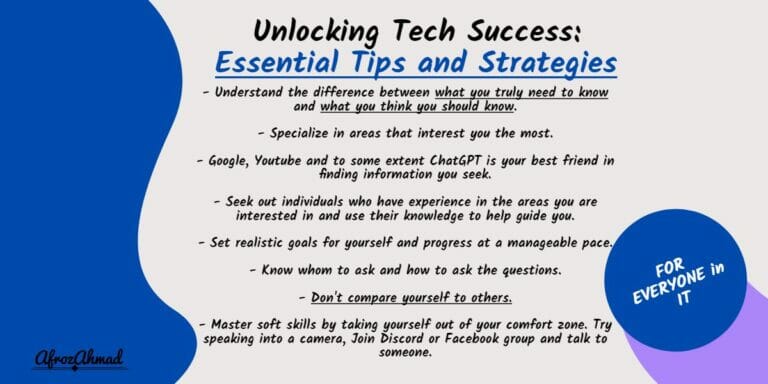Effective communication is an essential component of success in personal and professional relationships. Being able to convey your thoughts and ideas in a clear and concise manner can lead to better collaboration, fewer misunderstandings, and increased productivity. However, effective communication is not always easy. It requires practice, patience, and a willingness to learn.
In this article, we will explore guidelines to effective communication that can help improve your communication skills and enhance your relationships.
Make sure you read my blog posts covering various topics in our IT industry:
- How to be Successful in IT Industry: Essential Tips and Strategies
- How to Navigate the World of Network Engineering in 2023: Fundamentals, Trends, and Solutions
- How to Manage Stress and Burnout in the IT Industry: Reasons, Signs, and Best Practices
Why is Effective Communication Important for Personal and Professional Success?
Effective communication is essential to our daily lives. It can be used to express our feelings, inform others about important events and issues, or even just make small talk with friends and family. Effective communication is also important in the workplace, where it can help you build relationships with co-workers or supervisors that lead to promotions and job security.
Good communication leads to positive relationships and successful business partnerships, while poor communication can lead to misunderstandings, conflict, and lost opportunities. Effective communication also plays a crucial role in effective problem-solving and teamwork.
Luckily, effective communication is a skill that can be learned and improved with practice.
What are the Key Guidelines to Effective Communication?
Below are the key guidelines for effective communication.
- Understand your audience
- Choose the right medium
- Be clear and concise
- Listen carefully
- Provide context
- Use visual aids
- Be mindful of nonverbal communication
- Use feedback effectively
- Be respectful
- Follow up
- Avoid assumptions
- Emphasize action
- Be open-minded
- Avoid distractions
- Show empathy
- Use humor appropriately
- Practice active listening
- Be flexible
- Avoid negative language
- Practice, practice, practice

1. Understand Your Audience:
The first guideline to effective communication is to understand your audience. Whether you are communicating with coworkers, clients, or friends, it is important to consider their backgrounds, interests, and communication styles. This can help you tailor your message to better resonate with your audience and ensure that they understand your message.
2. Choose the Right Medium:
Different communication mediums have different strengths and weaknesses. Choosing the right medium can help you convey your message more effectively. For example,
- If you need to communicate complex ideas, an in-person meeting may be more effective than an email.
- On the other hand, if you need to communicate a quick update, an email may be more appropriate than a meeting.
3. Be Clear and Concise:
Clear and concise communication is key to effective communication.
Follow these helpful Tips for clarity and conciseness:
- Use simple language and avoid technical jargon or acronyms that may be unfamiliar to your audience.
- Be direct and to the point, and avoid rambling or going off on tangents.
- Structure your message: Organize your thoughts logically and present them in a coherent manner.
4. Listen Carefully:
Effective communication is a two-way street. It is just as important to listen carefully as it is to speak clearly.
Follow these helpful Tips for active listening:
- Make an effort to listen actively,
- ask clarifying questions, and
- summarize what you have heard to ensure that you understand the message.
5. Provide Context:
Context is important in effective communication. Providing background information or additional context can help your audience better understand your message and avoid misunderstandings.
6. Use Visual Aids:
Visual aids can be a powerful tool for effective communication. They can help convey complex ideas more clearly and concisely and reduce the risk of misunderstandings.
Examples of visual aids include charts, graphs, and diagrams.
7. Be Mindful of Nonverbal Communication:
Nonverbal communication can convey a lot of information. Follow these helpful Tips:
- Be mindful of your body language, facial expressions, and tone of voice.
- Avoid crossing your arms or appearing defensive, and
- use appropriate facial expressions and tone of voice to convey your message.
8. Use Feedback Effectively:
Feedback is an important aspect of effective communication. Whether you are giving or receiving feedback, it is important to be specific, constructive, and supportive. Use “I” statements and avoid sounding accusatory or judgmental.
Encouraging Feedback and its role in Communication
Feedback plays a vital role in communication by:
- Providing constructive feedback: Offer
- suggestions and insights that help others improve their communication skills and overall performance.
- Receiving feedback: Be open to receiving feedback from others and use it as an opportunity for growth and development.
- Creating a feedback culture: Foster an environment where open, honest feedback is valued and encouraged.
9. Be Respectful:
Respect is key to effective communication. Treat your audience with respect and avoid interrupting or talking over them. Use appropriate language and avoid using profanity or derogatory language.
10. Follow Up:
Following up after a communication can help ensure that your message is received and understood. This can include summarizing the key points of a meeting or sending a follow-up email to confirm the next steps.
11. Avoid Assumptions:
Assumptions can lead to misunderstandings and miscommunication. Avoid making assumptions about your audience’s knowledge or understanding, and take the time to clarify any misunderstandings.
12. Emphasize Action:
Effective communication should emphasize action. Use active language and provide clear next steps or action items to ensure that your message is acted upon.
13. Be Open-Minded:
Effective communication requires an open-minded attitude. Be willing to consider alternative viewpoints and listen to feedback from your audience.
14. Avoid Distractions:
Distractions can hinder effective communication. Avoid multitasking or checking your phone during a conversation, and make an effort to give your full attention to the conversation.
15. Develop and Show Empathy and Emotional Intelligence:
Empathy is an important aspect of effective communication. It involves understanding and sharing the feelings of your audience. Developing empathy in communication allows you to connect with others on a deeper level and fosters a supportive and nurturing environment. Showing empathy can help build rapport and trust and create a more positive communication experience.
Emotional intelligence and effective communication
Emotional intelligence involves recognizing, understanding, and managing emotions in yourself and others. It plays a critical role in effective communication by helping you:
- Identify emotions: Recognize the emotions you and others are experiencing during communication.
- Manage emotions: Regulate your emotions to maintain composure and respond appropriately to others’ emotions.
- Understand others’ emotions: Interpret the emotions of others to better understand their perspectives and respond accordingly.
16. Use Humor Appropriately
Humor can be a powerful tool in effective communication. It can help break the ice and make your audience feel more comfortable. However, it is important to use humor appropriately and avoid offensive or insensitive jokes.
17. Practice Active Listening
Active listening is a key aspect of effective communication. It involves fully engaging with the speaker and demonstrating that you are listening. This can include nodding, maintaining eye contact, and asking clarifying questions.
18. Be Flexible
Effective communication requires flexibility. Be willing to adapt your communication style to better suit your audience, and be open to feedback and suggestions for improvement.
Understanding communication styles
Different people have different communication styles, and it’s essential to recognize and adapt to these varying styles to ensure effective communication. Common communication styles include assertive, passive, aggressive, and passive-aggressive.
Adapting to different communication styles
To adapt to different communication styles:
- Observe and identify: Pay attention to the communication styles of those around you and recognize their preferred methods of expression.
- Adjust your approach: Modify your communication style to better align with the preferences of the person you’re communicating with.
- Be open-minded: Be willing to adapt and be flexible in your communication to create a more inclusive and understanding environment.
19. Avoid Negative Language
Negative language can be detrimental to effective communication. Avoid using language that is accusatory or judgmental, and focus on constructive and supportive language.
20. Practice, Practice, Practice
Effective communication requires practice. Take every opportunity to practice your communication skills, and seek feedback from others to improve your skills over time.
Barriers to Effective Communication
Barriers to effective communication can prevent you from getting your message across or understanding the message of others. Some common barriers include:
- Language barriers: If you’re communicating with someone who speaks a different language, it can be difficult to understand each other.
- Cultural barriers: Different cultures have different communication styles, which can make it difficult to understand each other.
- Physical barriers: Distance, noise, and other physical barriers can hinder effective communication.
- Emotional barriers: Strong emotions such as anger, fear, or anxiety can hinder effective communication.
- Technological barriers: Issues with technology, such as poor internet connection, can hinder effective communication.
To overcome these barriers, you can:
- Use clear language and avoid technical jargon.
- Be aware of cultural differences and adjust your communication style accordingly.
- Eliminate physical barriers by finding a quiet place to communicate and ensuring that your technology is working properly.
- Manage your emotions and be aware of the emotions of others.
- Use alternative communication methods, such as video conferencing or phone calls, if technology is causing issues.
By overcoming these barriers, you can improve your chances of effective communication and achieve your goals.
Conclusion
In conclusion, effective communication is an essential component of success in personal and professional relationships. By following these guidelines to effective communication, you can improve your communication skills and enhance your relationships.
Remember to understand your audience, choose the right medium, be clear and concise, listen carefully, provide context, use visual aids, be mindful of nonverbal communication, use feedback effectively, be respectful, follow up, avoid assumptions, emphasize action, be open-minded, avoid distractions, show empathy, use humor appropriately, practice active listening, be flexible, avoid negative language, and practice, practice, practice.
- How to Configure a Secure Site-to-Site VPN on Cisco Firepower Complete Guide - December 3, 2025
- Jobs for Network Engineers: Roles, Skills & Pay - December 3, 2025
- How to Change WiFi Password on Any Router : The Last Guide You Need - December 1, 2025




